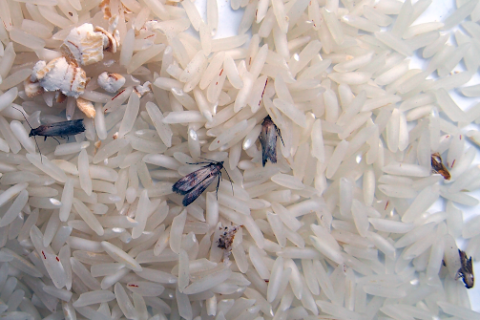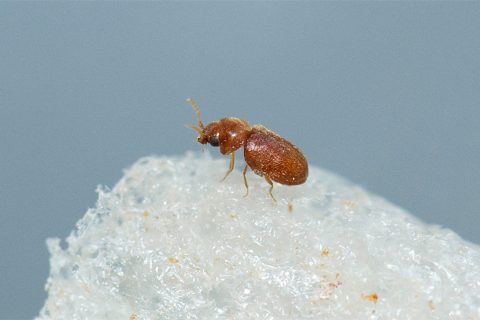Any Questions? Call us today!
All You Need To Know About Pantry Pests


All You Need To Know About Pantry Pests
Pantry pests are also known as “stored product pests” and are a group of insects that like to eat dried and processed foods that are found in people’s homes. Among these products we can find flour, cereals, dry pasta, dry pet food, powdered milk, crackers, spices, bread, bird seeds, dried nuts, fruits and more.
The most common insects from this category are the Indian meal moth, the saw toothed grain beetle and the cigarette beetle. Once they find a constant source of food, they can multiply very fast and can produce multiple generations in just one year.
What Do Pantry Pests Look Like?
As mentioned before, there are multiple insects in this category, but for now we’ll talk about the most common ones:
The Indian meal moth – these are small moths that have reddish brown forewings, a coppery look on the back side and grey on the front half. They are quite difficult to get rid of and their larvae can destroy a wide variety of foods in the house. They can crawl on ceilings and spin cocoons in other rooms of the home besides the kitchen.
The saw toothed grain beetle – these beetles have a slender, flat and brown body. They are about 1/10-inch-long and have six projections on each side of the thorax that look like teeth. In their case both the larvae and the adults feed on dried food, and they prefer flours, cereals, sweets, dried food or others. And they can even consume pet food, bird seeds and rodent bait.
The cigarette beetle – these are light brown beetle with a size of 1/8 inches. They have smooth wing covers, body hair that makes them look fuzzy and a hump-backed appearance. They got their name because they like to feed on cigars, cigarettes and cured tobacco. But they also like cereals, nuts, pet food or candies. And they may even infest spices such as paprika or chilli powder.
How Do You Get Pantry Pests?
These insects are not necessarily an indication of a dirty home or a bad house keeper. They can either get inside your home when searching for food, or can be brought in through packaged foods that were already infested. Just a few insects are enough to reproduce and to create serious damage. That’s why it is important to take action right from the first signs of pantry pests. If not treated, they can breed almost continuously, creating multiple generations over the course of one year.
The Signs of Pantry Pests
Not only these insects are very small, but they also have the colour of their food, which makes them quite difficult to spot. However, they are also attracted to light and that’s where you will spot them. So if you see moths flying around the kitchen or the food deposit area, or if you notice beetles around food packages, then it’s time to call a specialist.
Signs of pantry moths also include webbing along the corners of packages and even inside the products. Flours and cereals can have unpleasant smells or sticky secretions that causes the grains to clump together. If you notice small caterpillars or adult moths around the food areas, that’s also a clear sign of infestation.
Other subtle signs of pantry pests include the discolouration of flour, small holes in food packages, flour and grain mould and small traces of flour caused by the movements of the insects. These nasty insects are able to chew through paper, cardboard and even foil, so unopened packages can become infested as well if the pests are not taken care of.
Are Pantry Pests Dangerous?
The 3 species mentioned above are not dangerous. If you ate spoiled food or even accidentally swallowed an insect or its eggs, do not worry. They do not carry any known diseases or dangerous parasites. The biggest threat they pose is the destruction of food, creating waste and increasing the grocery expenses.
And least but not last, it is not pleasant to see beetles, moths and larvae in your kitchen or pantry, and to know that the food you are consuming might be infested. So that’s why it is important to take action from the first signs of pantry pests.
How To Get Rid of Pantry Pests?
If you find any insects or larvae in a package of food, seal that product in a plastic bag and throw it away in an outside bin. Also clean the shelves and cupboards thoroughly and keep dried foods in glass containers that are secured tightly.
But if pantry pests get out of hand, then it’s time to call a specialist. Do not try to apply insecticides yourself, as they might be harmful to people and pets if not used properly. Safeguard Pest Control is a family-owned and operated company that has been in business since 1989. We handle a wide variety of pests, including termites, lawn grubs, mice, rats, geckos, fleas, mosquitoes, flies, bed bugs, Silverfish and of course, pantry pests.
We have 30 years of experience and our employees are highly trained and skilled. They have great knowledge in this field and can provide great results for all types of buildings. We offer pest control solutions to both residential and commercial areas, as well as to schools and hospitals. We are using modern devices and safe substances that will not affect your health or the environment.
Get Rid of Pantry Pests Now!
If your home or yard are seriously infested by these insects, then it’s time to call a specialist! Book your Safeguard pantry pests treatment now by calling 07 5477 6675 or emailing info@safeguardpestcontrol.com.au and allow us to protect your home against these nasty insects.
Use the form below to request a Free Estimate . Requests are answered within 4 hours or less.
